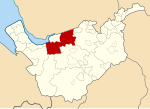St John the Evangelist's Church, Weston
1898 establishments in England19th-century Church of England church buildingsBuildings and structures in RuncornChurch of England church buildings in CheshireChurches completed in 1898 ... and 7 more
Diocese of ChesterEngvarB from September 2013Gothic Revival architecture in CheshireGothic Revival church buildings in EnglandGrade II* listed churches in CheshireJohn Douglas buildingsUse British English from December 2023

St John the Evangelist's Church is in Weston, once a separate village and now part of the town of Runcorn, Cheshire, England. The church is recorded in the National Heritage List for England as a designated Grade II* listed building. It is an active Anglican parish church in the diocese of Chester, the archdeaconry of Chester and the deanery of Frodsham. Its design has been described as "bold and original".
Excerpt from the Wikipedia article St John the Evangelist's Church, Weston (License: CC BY-SA 3.0, Authors, Images).St John the Evangelist's Church, Weston
Heath Road South,
Geographical coordinates (GPS) Address External links Nearby Places Show on map
Geographical coordinates (GPS)
| Latitude | Longitude |
|---|---|
| N 53.319 ° | E -2.73885 ° |
Address
St John's
Heath Road South
WA7 4LY , Runcorn Heath
England, United Kingdom
Open on Google Maps








